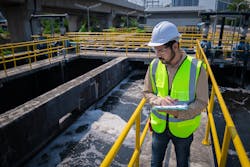Clean water is essential to modern society, and despite extreme weather events, an aging electric infrastructure and increased security concerns that threaten the power supply, the utilities that pump, treat, and distribute water must have reliable power. Access to clean water is crucial to protecting public health and safety.
Increasingly, water utilities are turning to microgrids to provide the resiliency they need.
The benefits of a microgrid
You can think of a microgrid as a mini, localized version of the electric grid. It's a resilient energy system that serves a discrete geographic footprint, such as water facilities, campuses, health care facilities, business centers or neighborhoods.
The microgrid's controller allows the system to disconnect from the main power grid in case of an outage; this is known as islanding. When a microgrid is in island mode, local energy resources such as a solar array or batter energy storage system, provide the electricity needed to keep operations running. Once grid power is restored, the microgrid's controller automatically switches back to grid power.
Microgrids provide much more than just resilient power. That same controller can also be programmed to optimize energy use from a variety of sources – be they connected renewable sources or the grid – to meet the facility's goals.
If reducing carbon emissions is the primary goal, the microgrid will prioritize the use of the system's connected renewable energy sources at all times.
If reducing energy costs is the primary goal, the microgrid will prioritize the use the of the system's connected renewable energy sources during peak demand hours or when the price of energy is higher.
Want to learn more?
To help you better understand how water utilities can benefit from microgrid technology, Microgrid Knowledge has produced an educational series on the topic.
We invite you to review the following information on microgrids for water and wastewater facilities to learn more:
Why microgrids for water and wastewater facilities








